HSH703 Health Promotion: Glenelg Shire Youth & Alcohol Intervention
VerifiedAdded on 2023/06/11
|12
|4086
|325
Report
AI Summary
This report delves into health promotion interventions aimed at addressing underage drinking within the Glenelg Shire community, particularly focusing on youth in years 6 and 8. The 'You're Enough' campaign, developed by the Glenelg Alcohol Health Promotion Planning Committee (AHPPC) and Glenelg Beyond The Bell (BTB), seeks to delay alcohol consumption by instilling self-esteem and educating both children and parents about the detrimental effects of early alcohol exposure on cognitive development and academic performance. The report discusses determinants of health, including social, psychological, behavioral, and peer influences, and assesses the health promotion intervention using frameworks like RE-AIM. It also compares the intervention to the Commission on Social Determinants of Health's 'Close the Gap' initiative and aligns it with Kickbusch’s five key determinants of health, emphasizing economic stability and education. The report further explores systems thinking approaches and the promotion of equity and environmental stability through health promotion efforts.
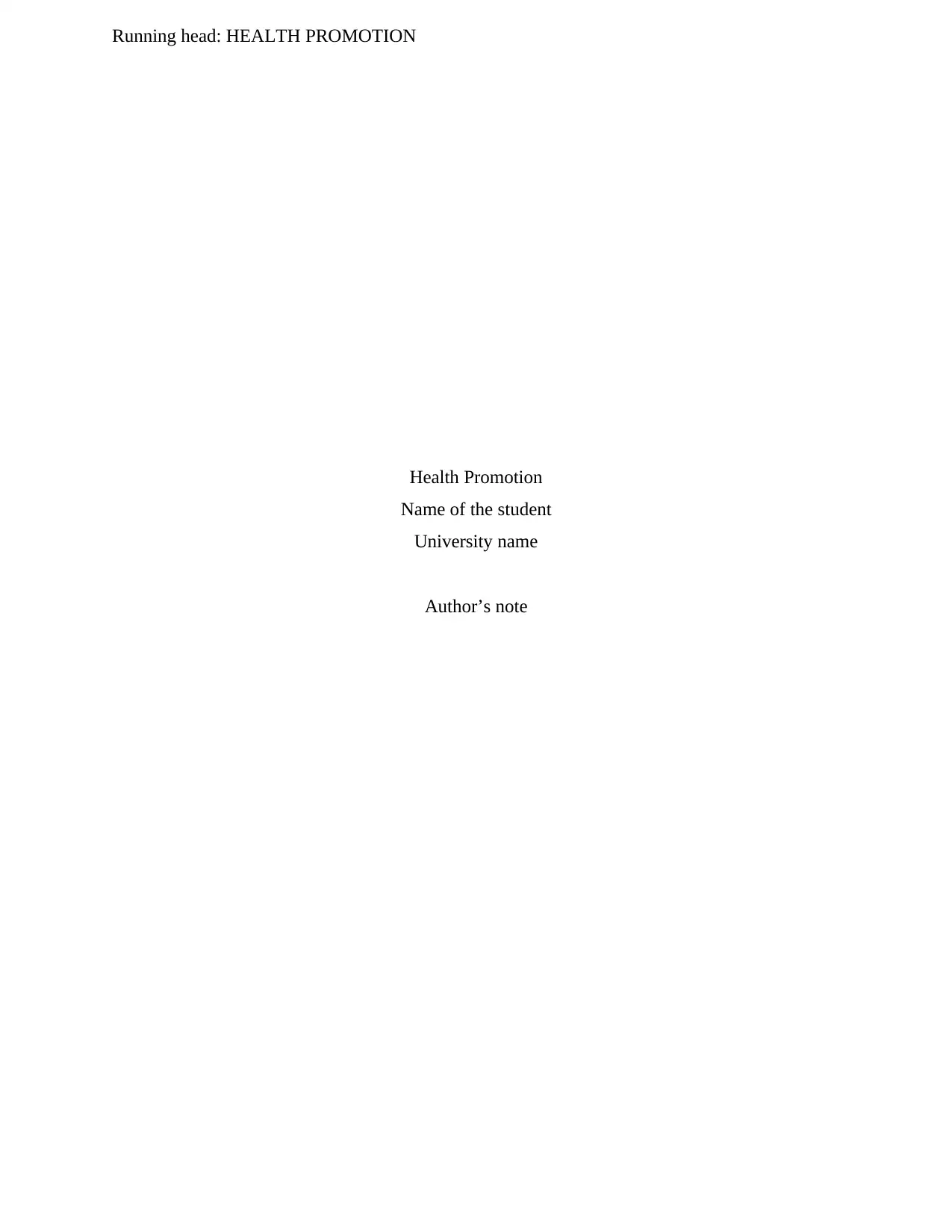
Running head: HEALTH PROMOTION
Health Promotion
Name of the student
University name
Author’s note
Health Promotion
Name of the student
University name
Author’s note
Paraphrase This Document
Need a fresh take? Get an instant paraphrase of this document with our AI Paraphraser
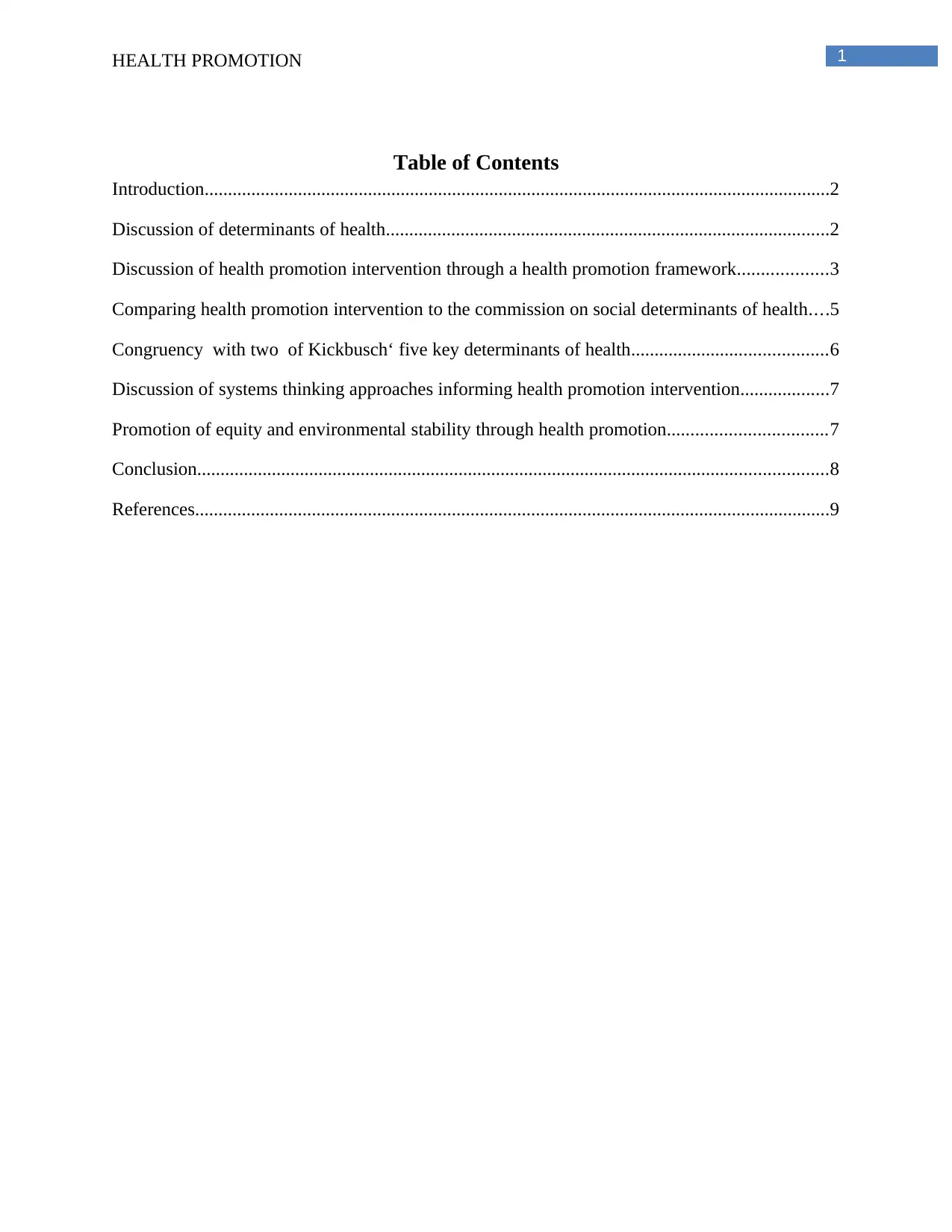
1HEALTH PROMOTION
Table of Contents
Introduction......................................................................................................................................2
Discussion of determinants of health...............................................................................................2
Discussion of health promotion intervention through a health promotion framework...................3
Comparing health promotion intervention to the commission on social determinants of health....5
Congruency with two of Kickbusch‘ five key determinants of health..........................................6
Discussion of systems thinking approaches informing health promotion intervention...................7
Promotion of equity and environmental stability through health promotion..................................7
Conclusion.......................................................................................................................................8
References........................................................................................................................................9
Table of Contents
Introduction......................................................................................................................................2
Discussion of determinants of health...............................................................................................2
Discussion of health promotion intervention through a health promotion framework...................3
Comparing health promotion intervention to the commission on social determinants of health....5
Congruency with two of Kickbusch‘ five key determinants of health..........................................6
Discussion of systems thinking approaches informing health promotion intervention...................7
Promotion of equity and environmental stability through health promotion..................................7
Conclusion.......................................................................................................................................8
References........................................................................................................................................9
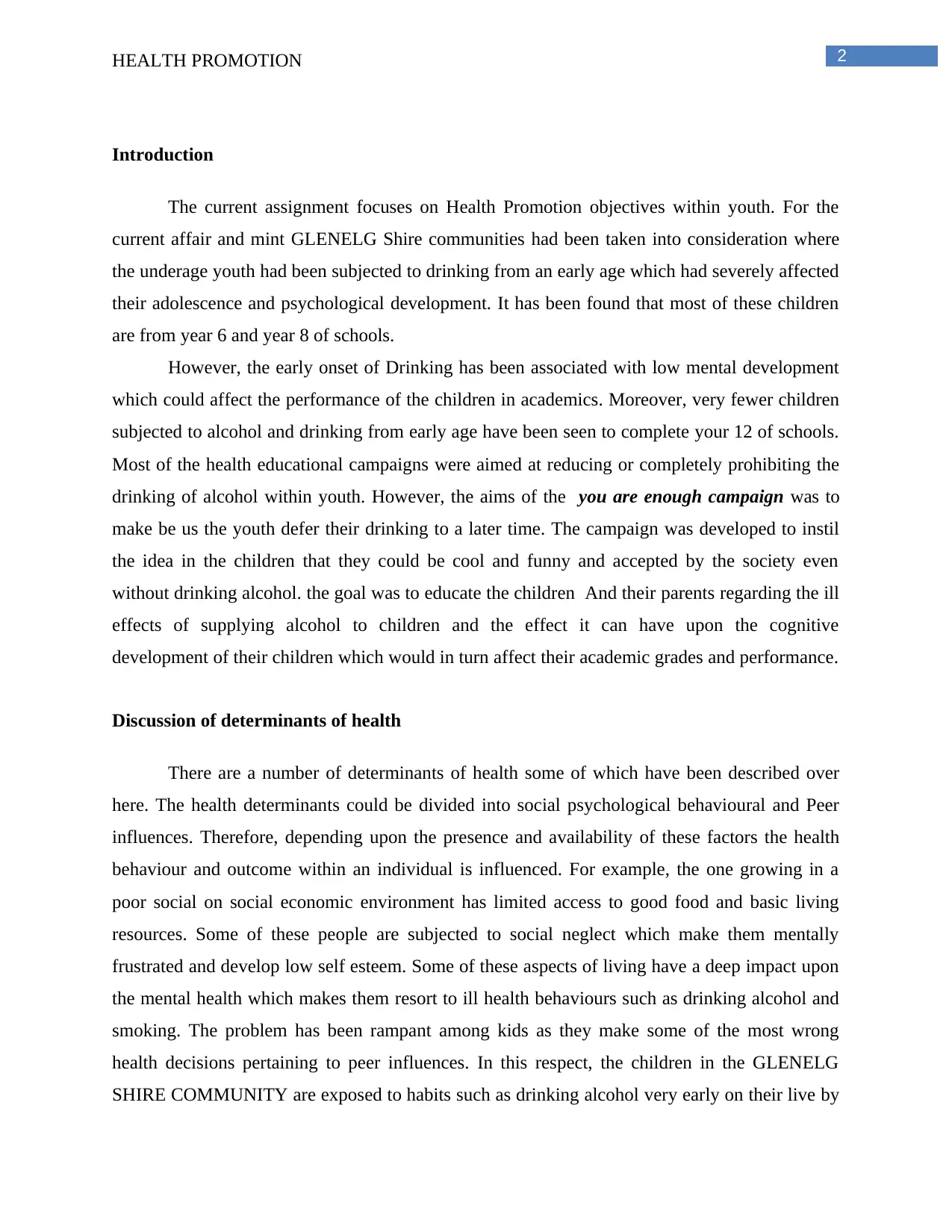
2HEALTH PROMOTION
Introduction
The current assignment focuses on Health Promotion objectives within youth. For the
current affair and mint GLENELG Shire communities had been taken into consideration where
the underage youth had been subjected to drinking from an early age which had severely affected
their adolescence and psychological development. It has been found that most of these children
are from year 6 and year 8 of schools.
However, the early onset of Drinking has been associated with low mental development
which could affect the performance of the children in academics. Moreover, very fewer children
subjected to alcohol and drinking from early age have been seen to complete your 12 of schools.
Most of the health educational campaigns were aimed at reducing or completely prohibiting the
drinking of alcohol within youth. However, the aims of the you are enough campaign was to
make be us the youth defer their drinking to a later time. The campaign was developed to instil
the idea in the children that they could be cool and funny and accepted by the society even
without drinking alcohol. the goal was to educate the children And their parents regarding the ill
effects of supplying alcohol to children and the effect it can have upon the cognitive
development of their children which would in turn affect their academic grades and performance.
Discussion of determinants of health
There are a number of determinants of health some of which have been described over
here. The health determinants could be divided into social psychological behavioural and Peer
influences. Therefore, depending upon the presence and availability of these factors the health
behaviour and outcome within an individual is influenced. For example, the one growing in a
poor social on social economic environment has limited access to good food and basic living
resources. Some of these people are subjected to social neglect which make them mentally
frustrated and develop low self esteem. Some of these aspects of living have a deep impact upon
the mental health which makes them resort to ill health behaviours such as drinking alcohol and
smoking. The problem has been rampant among kids as they make some of the most wrong
health decisions pertaining to peer influences. In this respect, the children in the GLENELG
SHIRE COMMUNITY are exposed to habits such as drinking alcohol very early on their live by
Introduction
The current assignment focuses on Health Promotion objectives within youth. For the
current affair and mint GLENELG Shire communities had been taken into consideration where
the underage youth had been subjected to drinking from an early age which had severely affected
their adolescence and psychological development. It has been found that most of these children
are from year 6 and year 8 of schools.
However, the early onset of Drinking has been associated with low mental development
which could affect the performance of the children in academics. Moreover, very fewer children
subjected to alcohol and drinking from early age have been seen to complete your 12 of schools.
Most of the health educational campaigns were aimed at reducing or completely prohibiting the
drinking of alcohol within youth. However, the aims of the you are enough campaign was to
make be us the youth defer their drinking to a later time. The campaign was developed to instil
the idea in the children that they could be cool and funny and accepted by the society even
without drinking alcohol. the goal was to educate the children And their parents regarding the ill
effects of supplying alcohol to children and the effect it can have upon the cognitive
development of their children which would in turn affect their academic grades and performance.
Discussion of determinants of health
There are a number of determinants of health some of which have been described over
here. The health determinants could be divided into social psychological behavioural and Peer
influences. Therefore, depending upon the presence and availability of these factors the health
behaviour and outcome within an individual is influenced. For example, the one growing in a
poor social on social economic environment has limited access to good food and basic living
resources. Some of these people are subjected to social neglect which make them mentally
frustrated and develop low self esteem. Some of these aspects of living have a deep impact upon
the mental health which makes them resort to ill health behaviours such as drinking alcohol and
smoking. The problem has been rampant among kids as they make some of the most wrong
health decisions pertaining to peer influences. In this respect, the children in the GLENELG
SHIRE COMMUNITY are exposed to habits such as drinking alcohol very early on their live by
⊘ This is a preview!⊘
Do you want full access?
Subscribe today to unlock all pages.

Trusted by 1+ million students worldwide
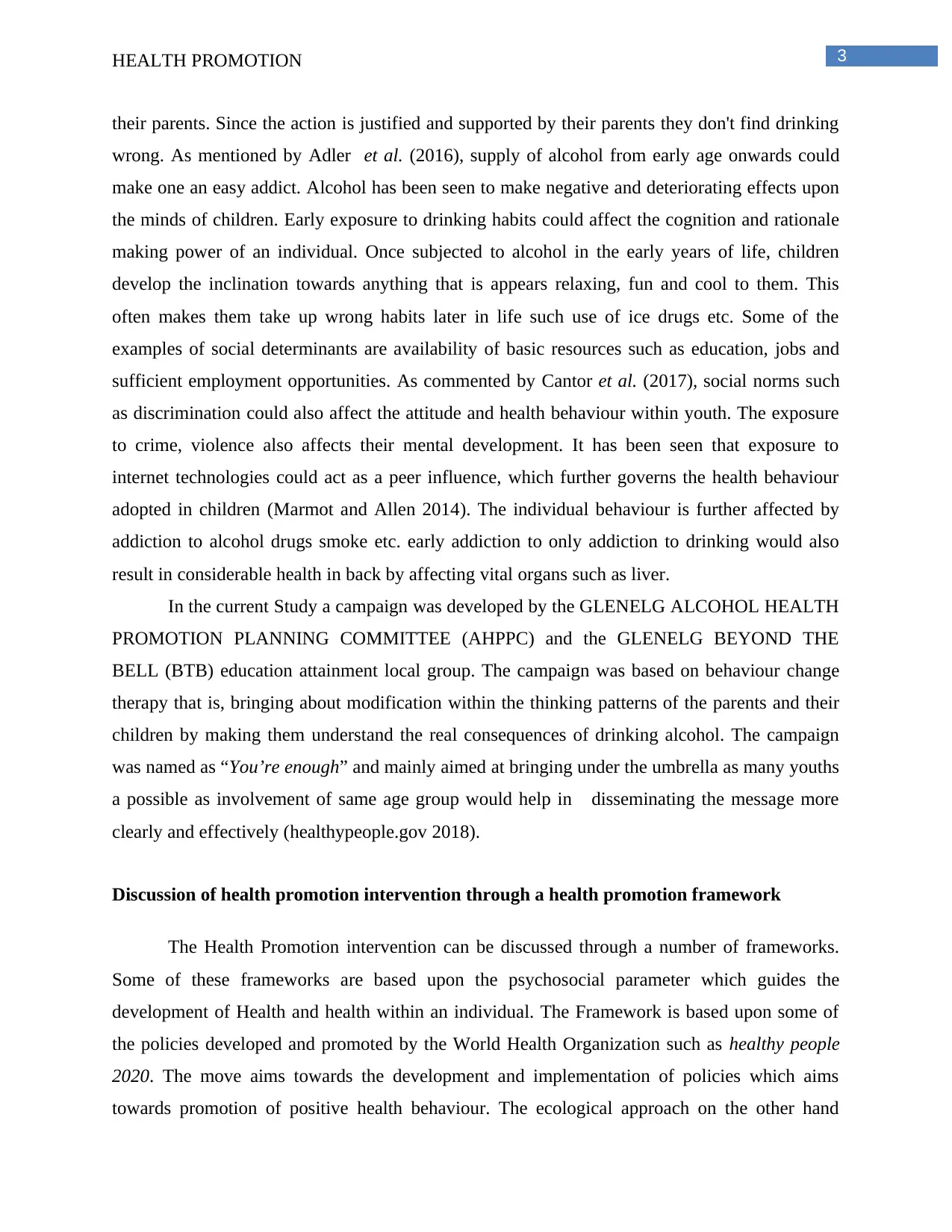
3HEALTH PROMOTION
their parents. Since the action is justified and supported by their parents they don't find drinking
wrong. As mentioned by Adler et al. (2016), supply of alcohol from early age onwards could
make one an easy addict. Alcohol has been seen to make negative and deteriorating effects upon
the minds of children. Early exposure to drinking habits could affect the cognition and rationale
making power of an individual. Once subjected to alcohol in the early years of life, children
develop the inclination towards anything that is appears relaxing, fun and cool to them. This
often makes them take up wrong habits later in life such use of ice drugs etc. Some of the
examples of social determinants are availability of basic resources such as education, jobs and
sufficient employment opportunities. As commented by Cantor et al. (2017), social norms such
as discrimination could also affect the attitude and health behaviour within youth. The exposure
to crime, violence also affects their mental development. It has been seen that exposure to
internet technologies could act as a peer influence, which further governs the health behaviour
adopted in children (Marmot and Allen 2014). The individual behaviour is further affected by
addiction to alcohol drugs smoke etc. early addiction to only addiction to drinking would also
result in considerable health in back by affecting vital organs such as liver.
In the current Study a campaign was developed by the GLENELG ALCOHOL HEALTH
PROMOTION PLANNING COMMITTEE (AHPPC) and the GLENELG BEYOND THE
BELL (BTB) education attainment local group. The campaign was based on behaviour change
therapy that is, bringing about modification within the thinking patterns of the parents and their
children by making them understand the real consequences of drinking alcohol. The campaign
was named as “You’re enough” and mainly aimed at bringing under the umbrella as many youths
a possible as involvement of same age group would help in disseminating the message more
clearly and effectively (healthypeople.gov 2018).
Discussion of health promotion intervention through a health promotion framework
The Health Promotion intervention can be discussed through a number of frameworks.
Some of these frameworks are based upon the psychosocial parameter which guides the
development of Health and health within an individual. The Framework is based upon some of
the policies developed and promoted by the World Health Organization such as healthy people
2020. The move aims towards the development and implementation of policies which aims
towards promotion of positive health behaviour. The ecological approach on the other hand
their parents. Since the action is justified and supported by their parents they don't find drinking
wrong. As mentioned by Adler et al. (2016), supply of alcohol from early age onwards could
make one an easy addict. Alcohol has been seen to make negative and deteriorating effects upon
the minds of children. Early exposure to drinking habits could affect the cognition and rationale
making power of an individual. Once subjected to alcohol in the early years of life, children
develop the inclination towards anything that is appears relaxing, fun and cool to them. This
often makes them take up wrong habits later in life such use of ice drugs etc. Some of the
examples of social determinants are availability of basic resources such as education, jobs and
sufficient employment opportunities. As commented by Cantor et al. (2017), social norms such
as discrimination could also affect the attitude and health behaviour within youth. The exposure
to crime, violence also affects their mental development. It has been seen that exposure to
internet technologies could act as a peer influence, which further governs the health behaviour
adopted in children (Marmot and Allen 2014). The individual behaviour is further affected by
addiction to alcohol drugs smoke etc. early addiction to only addiction to drinking would also
result in considerable health in back by affecting vital organs such as liver.
In the current Study a campaign was developed by the GLENELG ALCOHOL HEALTH
PROMOTION PLANNING COMMITTEE (AHPPC) and the GLENELG BEYOND THE
BELL (BTB) education attainment local group. The campaign was based on behaviour change
therapy that is, bringing about modification within the thinking patterns of the parents and their
children by making them understand the real consequences of drinking alcohol. The campaign
was named as “You’re enough” and mainly aimed at bringing under the umbrella as many youths
a possible as involvement of same age group would help in disseminating the message more
clearly and effectively (healthypeople.gov 2018).
Discussion of health promotion intervention through a health promotion framework
The Health Promotion intervention can be discussed through a number of frameworks.
Some of these frameworks are based upon the psychosocial parameter which guides the
development of Health and health within an individual. The Framework is based upon some of
the policies developed and promoted by the World Health Organization such as healthy people
2020. The move aims towards the development and implementation of policies which aims
towards promotion of positive health behaviour. The ecological approach on the other hand
Paraphrase This Document
Need a fresh take? Get an instant paraphrase of this document with our AI Paraphraser
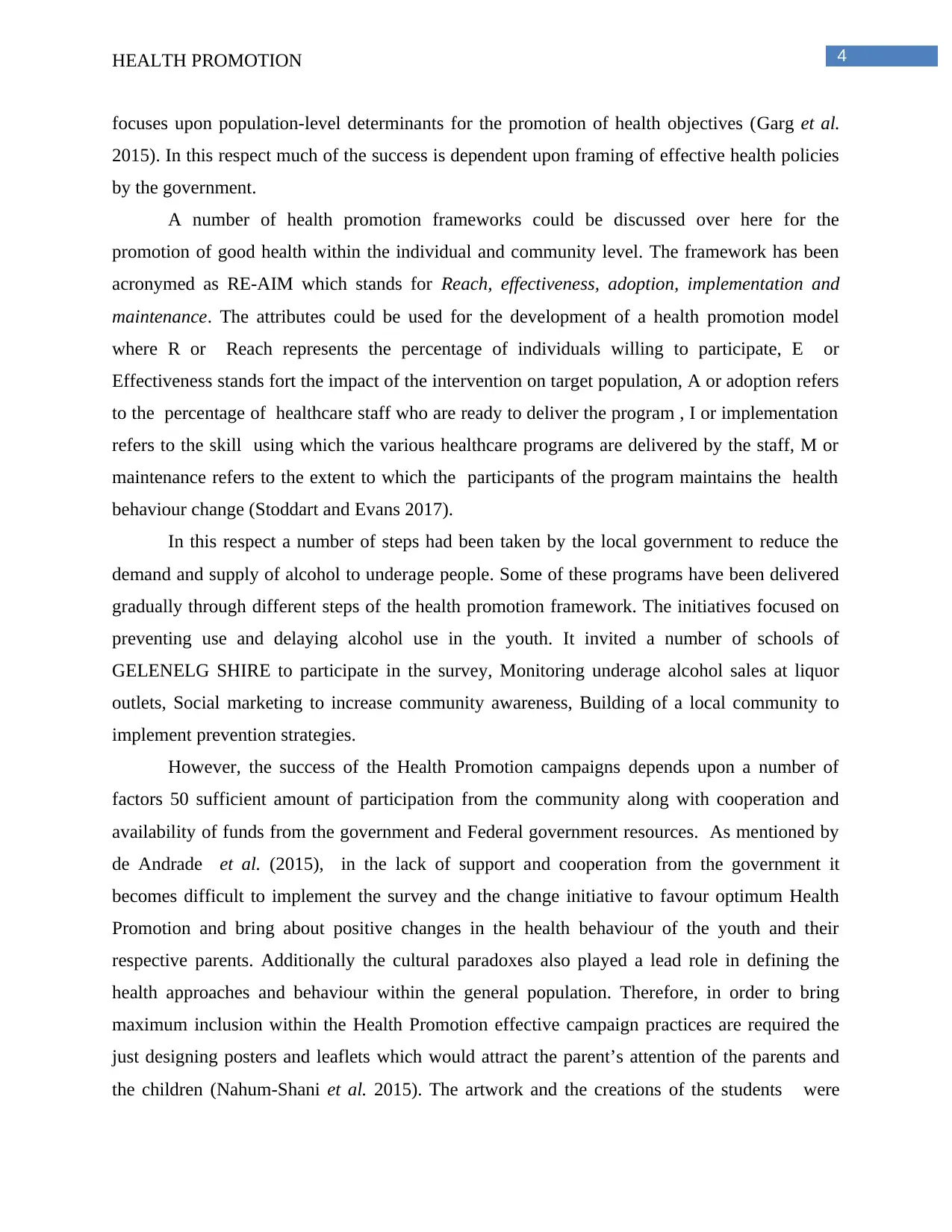
4HEALTH PROMOTION
focuses upon population-level determinants for the promotion of health objectives (Garg et al.
2015). In this respect much of the success is dependent upon framing of effective health policies
by the government.
A number of health promotion frameworks could be discussed over here for the
promotion of good health within the individual and community level. The framework has been
acronymed as RE-AIM which stands for Reach, effectiveness, adoption, implementation and
maintenance. The attributes could be used for the development of a health promotion model
where R or Reach represents the percentage of individuals willing to participate, E or
Effectiveness stands fort the impact of the intervention on target population, A or adoption refers
to the percentage of healthcare staff who are ready to deliver the program , I or implementation
refers to the skill using which the various healthcare programs are delivered by the staff, M or
maintenance refers to the extent to which the participants of the program maintains the health
behaviour change (Stoddart and Evans 2017).
In this respect a number of steps had been taken by the local government to reduce the
demand and supply of alcohol to underage people. Some of these programs have been delivered
gradually through different steps of the health promotion framework. The initiatives focused on
preventing use and delaying alcohol use in the youth. It invited a number of schools of
GELENELG SHIRE to participate in the survey, Monitoring underage alcohol sales at liquor
outlets, Social marketing to increase community awareness, Building of a local community to
implement prevention strategies.
However, the success of the Health Promotion campaigns depends upon a number of
factors 50 sufficient amount of participation from the community along with cooperation and
availability of funds from the government and Federal government resources. As mentioned by
de Andrade et al. (2015), in the lack of support and cooperation from the government it
becomes difficult to implement the survey and the change initiative to favour optimum Health
Promotion and bring about positive changes in the health behaviour of the youth and their
respective parents. Additionally the cultural paradoxes also played a lead role in defining the
health approaches and behaviour within the general population. Therefore, in order to bring
maximum inclusion within the Health Promotion effective campaign practices are required the
just designing posters and leaflets which would attract the parent’s attention of the parents and
the children (Nahum-Shani et al. 2015). The artwork and the creations of the students were
focuses upon population-level determinants for the promotion of health objectives (Garg et al.
2015). In this respect much of the success is dependent upon framing of effective health policies
by the government.
A number of health promotion frameworks could be discussed over here for the
promotion of good health within the individual and community level. The framework has been
acronymed as RE-AIM which stands for Reach, effectiveness, adoption, implementation and
maintenance. The attributes could be used for the development of a health promotion model
where R or Reach represents the percentage of individuals willing to participate, E or
Effectiveness stands fort the impact of the intervention on target population, A or adoption refers
to the percentage of healthcare staff who are ready to deliver the program , I or implementation
refers to the skill using which the various healthcare programs are delivered by the staff, M or
maintenance refers to the extent to which the participants of the program maintains the health
behaviour change (Stoddart and Evans 2017).
In this respect a number of steps had been taken by the local government to reduce the
demand and supply of alcohol to underage people. Some of these programs have been delivered
gradually through different steps of the health promotion framework. The initiatives focused on
preventing use and delaying alcohol use in the youth. It invited a number of schools of
GELENELG SHIRE to participate in the survey, Monitoring underage alcohol sales at liquor
outlets, Social marketing to increase community awareness, Building of a local community to
implement prevention strategies.
However, the success of the Health Promotion campaigns depends upon a number of
factors 50 sufficient amount of participation from the community along with cooperation and
availability of funds from the government and Federal government resources. As mentioned by
de Andrade et al. (2015), in the lack of support and cooperation from the government it
becomes difficult to implement the survey and the change initiative to favour optimum Health
Promotion and bring about positive changes in the health behaviour of the youth and their
respective parents. Additionally the cultural paradoxes also played a lead role in defining the
health approaches and behaviour within the general population. Therefore, in order to bring
maximum inclusion within the Health Promotion effective campaign practices are required the
just designing posters and leaflets which would attract the parent’s attention of the parents and
the children (Nahum-Shani et al. 2015). The artwork and the creations of the students were
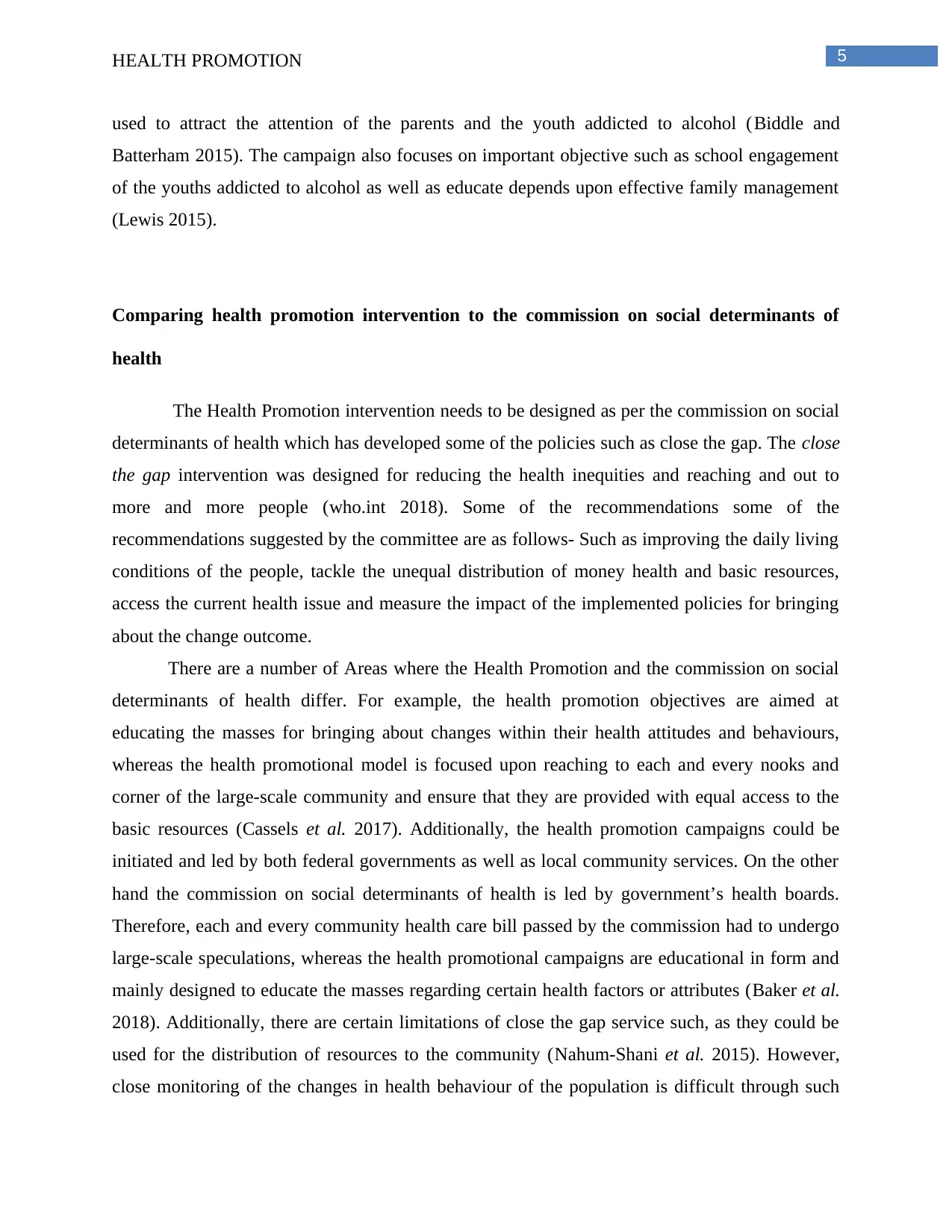
5HEALTH PROMOTION
used to attract the attention of the parents and the youth addicted to alcohol (Biddle and
Batterham 2015). The campaign also focuses on important objective such as school engagement
of the youths addicted to alcohol as well as educate depends upon effective family management
(Lewis 2015).
Comparing health promotion intervention to the commission on social determinants of
health
The Health Promotion intervention needs to be designed as per the commission on social
determinants of health which has developed some of the policies such as close the gap. The close
the gap intervention was designed for reducing the health inequities and reaching and out to
more and more people (who.int 2018). Some of the recommendations some of the
recommendations suggested by the committee are as follows- Such as improving the daily living
conditions of the people, tackle the unequal distribution of money health and basic resources,
access the current health issue and measure the impact of the implemented policies for bringing
about the change outcome.
There are a number of Areas where the Health Promotion and the commission on social
determinants of health differ. For example, the health promotion objectives are aimed at
educating the masses for bringing about changes within their health attitudes and behaviours,
whereas the health promotional model is focused upon reaching to each and every nooks and
corner of the large-scale community and ensure that they are provided with equal access to the
basic resources (Cassels et al. 2017). Additionally, the health promotion campaigns could be
initiated and led by both federal governments as well as local community services. On the other
hand the commission on social determinants of health is led by government’s health boards.
Therefore, each and every community health care bill passed by the commission had to undergo
large-scale speculations, whereas the health promotional campaigns are educational in form and
mainly designed to educate the masses regarding certain health factors or attributes (Baker et al.
2018). Additionally, there are certain limitations of close the gap service such, as they could be
used for the distribution of resources to the community (Nahum-Shani et al. 2015). However,
close monitoring of the changes in health behaviour of the population is difficult through such
used to attract the attention of the parents and the youth addicted to alcohol (Biddle and
Batterham 2015). The campaign also focuses on important objective such as school engagement
of the youths addicted to alcohol as well as educate depends upon effective family management
(Lewis 2015).
Comparing health promotion intervention to the commission on social determinants of
health
The Health Promotion intervention needs to be designed as per the commission on social
determinants of health which has developed some of the policies such as close the gap. The close
the gap intervention was designed for reducing the health inequities and reaching and out to
more and more people (who.int 2018). Some of the recommendations some of the
recommendations suggested by the committee are as follows- Such as improving the daily living
conditions of the people, tackle the unequal distribution of money health and basic resources,
access the current health issue and measure the impact of the implemented policies for bringing
about the change outcome.
There are a number of Areas where the Health Promotion and the commission on social
determinants of health differ. For example, the health promotion objectives are aimed at
educating the masses for bringing about changes within their health attitudes and behaviours,
whereas the health promotional model is focused upon reaching to each and every nooks and
corner of the large-scale community and ensure that they are provided with equal access to the
basic resources (Cassels et al. 2017). Additionally, the health promotion campaigns could be
initiated and led by both federal governments as well as local community services. On the other
hand the commission on social determinants of health is led by government’s health boards.
Therefore, each and every community health care bill passed by the commission had to undergo
large-scale speculations, whereas the health promotional campaigns are educational in form and
mainly designed to educate the masses regarding certain health factors or attributes (Baker et al.
2018). Additionally, there are certain limitations of close the gap service such, as they could be
used for the distribution of resources to the community (Nahum-Shani et al. 2015). However,
close monitoring of the changes in health behaviour of the population is difficult through such
⊘ This is a preview!⊘
Do you want full access?
Subscribe today to unlock all pages.

Trusted by 1+ million students worldwide
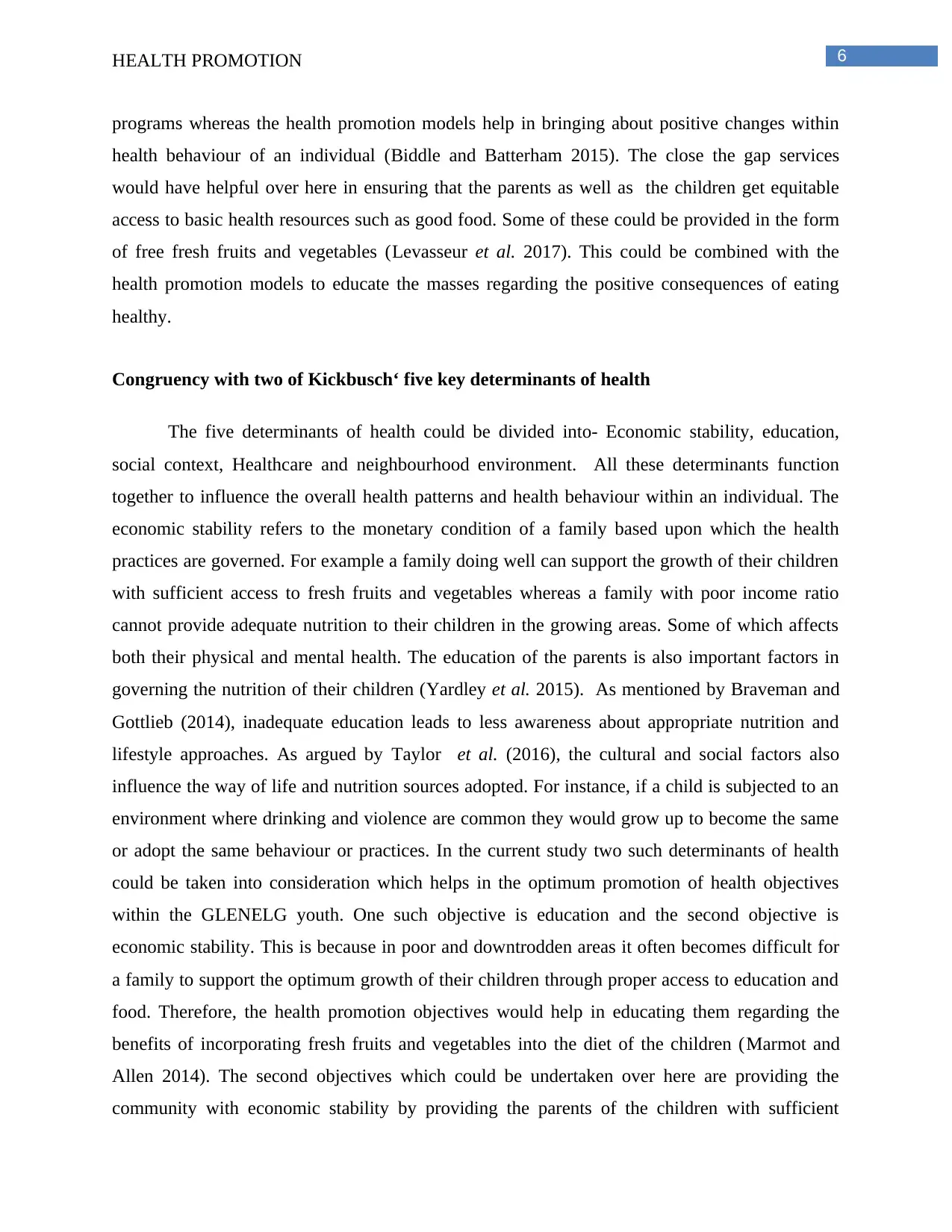
6HEALTH PROMOTION
programs whereas the health promotion models help in bringing about positive changes within
health behaviour of an individual (Biddle and Batterham 2015). The close the gap services
would have helpful over here in ensuring that the parents as well as the children get equitable
access to basic health resources such as good food. Some of these could be provided in the form
of free fresh fruits and vegetables (Levasseur et al. 2017). This could be combined with the
health promotion models to educate the masses regarding the positive consequences of eating
healthy.
Congruency with two of Kickbusch‘ five key determinants of health
The five determinants of health could be divided into- Economic stability, education,
social context, Healthcare and neighbourhood environment. All these determinants function
together to influence the overall health patterns and health behaviour within an individual. The
economic stability refers to the monetary condition of a family based upon which the health
practices are governed. For example a family doing well can support the growth of their children
with sufficient access to fresh fruits and vegetables whereas a family with poor income ratio
cannot provide adequate nutrition to their children in the growing areas. Some of which affects
both their physical and mental health. The education of the parents is also important factors in
governing the nutrition of their children (Yardley et al. 2015). As mentioned by Braveman and
Gottlieb (2014), inadequate education leads to less awareness about appropriate nutrition and
lifestyle approaches. As argued by Taylor et al. (2016), the cultural and social factors also
influence the way of life and nutrition sources adopted. For instance, if a child is subjected to an
environment where drinking and violence are common they would grow up to become the same
or adopt the same behaviour or practices. In the current study two such determinants of health
could be taken into consideration which helps in the optimum promotion of health objectives
within the GLENELG youth. One such objective is education and the second objective is
economic stability. This is because in poor and downtrodden areas it often becomes difficult for
a family to support the optimum growth of their children through proper access to education and
food. Therefore, the health promotion objectives would help in educating them regarding the
benefits of incorporating fresh fruits and vegetables into the diet of the children (Marmot and
Allen 2014). The second objectives which could be undertaken over here are providing the
community with economic stability by providing the parents of the children with sufficient
programs whereas the health promotion models help in bringing about positive changes within
health behaviour of an individual (Biddle and Batterham 2015). The close the gap services
would have helpful over here in ensuring that the parents as well as the children get equitable
access to basic health resources such as good food. Some of these could be provided in the form
of free fresh fruits and vegetables (Levasseur et al. 2017). This could be combined with the
health promotion models to educate the masses regarding the positive consequences of eating
healthy.
Congruency with two of Kickbusch‘ five key determinants of health
The five determinants of health could be divided into- Economic stability, education,
social context, Healthcare and neighbourhood environment. All these determinants function
together to influence the overall health patterns and health behaviour within an individual. The
economic stability refers to the monetary condition of a family based upon which the health
practices are governed. For example a family doing well can support the growth of their children
with sufficient access to fresh fruits and vegetables whereas a family with poor income ratio
cannot provide adequate nutrition to their children in the growing areas. Some of which affects
both their physical and mental health. The education of the parents is also important factors in
governing the nutrition of their children (Yardley et al. 2015). As mentioned by Braveman and
Gottlieb (2014), inadequate education leads to less awareness about appropriate nutrition and
lifestyle approaches. As argued by Taylor et al. (2016), the cultural and social factors also
influence the way of life and nutrition sources adopted. For instance, if a child is subjected to an
environment where drinking and violence are common they would grow up to become the same
or adopt the same behaviour or practices. In the current study two such determinants of health
could be taken into consideration which helps in the optimum promotion of health objectives
within the GLENELG youth. One such objective is education and the second objective is
economic stability. This is because in poor and downtrodden areas it often becomes difficult for
a family to support the optimum growth of their children through proper access to education and
food. Therefore, the health promotion objectives would help in educating them regarding the
benefits of incorporating fresh fruits and vegetables into the diet of the children (Marmot and
Allen 2014). The second objectives which could be undertaken over here are providing the
community with economic stability by providing the parents of the children with sufficient
Paraphrase This Document
Need a fresh take? Get an instant paraphrase of this document with our AI Paraphraser
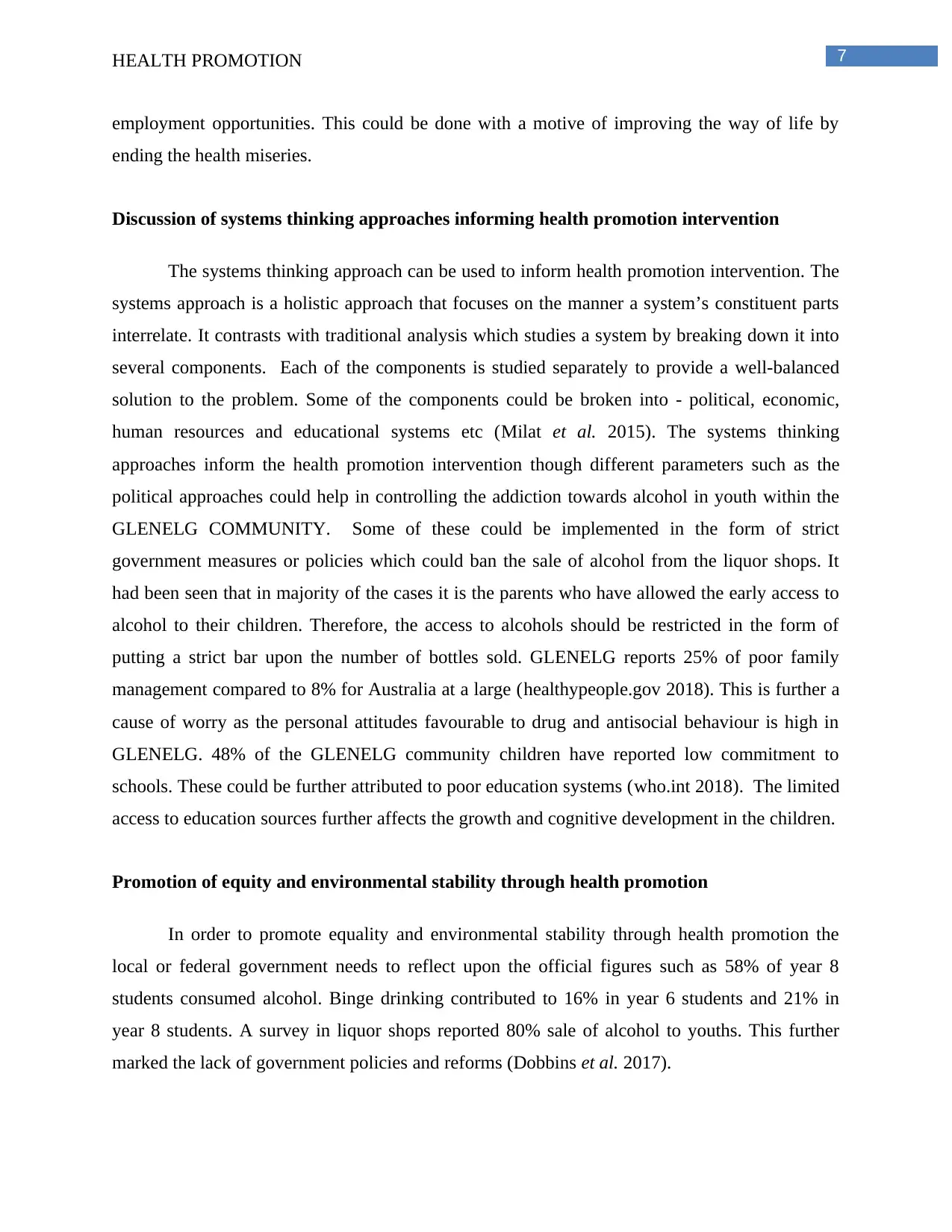
7HEALTH PROMOTION
employment opportunities. This could be done with a motive of improving the way of life by
ending the health miseries.
Discussion of systems thinking approaches informing health promotion intervention
The systems thinking approach can be used to inform health promotion intervention. The
systems approach is a holistic approach that focuses on the manner a system’s constituent parts
interrelate. It contrasts with traditional analysis which studies a system by breaking down it into
several components. Each of the components is studied separately to provide a well-balanced
solution to the problem. Some of the components could be broken into - political, economic,
human resources and educational systems etc (Milat et al. 2015). The systems thinking
approaches inform the health promotion intervention though different parameters such as the
political approaches could help in controlling the addiction towards alcohol in youth within the
GLENELG COMMUNITY. Some of these could be implemented in the form of strict
government measures or policies which could ban the sale of alcohol from the liquor shops. It
had been seen that in majority of the cases it is the parents who have allowed the early access to
alcohol to their children. Therefore, the access to alcohols should be restricted in the form of
putting a strict bar upon the number of bottles sold. GLENELG reports 25% of poor family
management compared to 8% for Australia at a large (healthypeople.gov 2018). This is further a
cause of worry as the personal attitudes favourable to drug and antisocial behaviour is high in
GLENELG. 48% of the GLENELG community children have reported low commitment to
schools. These could be further attributed to poor education systems (who.int 2018). The limited
access to education sources further affects the growth and cognitive development in the children.
Promotion of equity and environmental stability through health promotion
In order to promote equality and environmental stability through health promotion the
local or federal government needs to reflect upon the official figures such as 58% of year 8
students consumed alcohol. Binge drinking contributed to 16% in year 6 students and 21% in
year 8 students. A survey in liquor shops reported 80% sale of alcohol to youths. This further
marked the lack of government policies and reforms (Dobbins et al. 2017).
employment opportunities. This could be done with a motive of improving the way of life by
ending the health miseries.
Discussion of systems thinking approaches informing health promotion intervention
The systems thinking approach can be used to inform health promotion intervention. The
systems approach is a holistic approach that focuses on the manner a system’s constituent parts
interrelate. It contrasts with traditional analysis which studies a system by breaking down it into
several components. Each of the components is studied separately to provide a well-balanced
solution to the problem. Some of the components could be broken into - political, economic,
human resources and educational systems etc (Milat et al. 2015). The systems thinking
approaches inform the health promotion intervention though different parameters such as the
political approaches could help in controlling the addiction towards alcohol in youth within the
GLENELG COMMUNITY. Some of these could be implemented in the form of strict
government measures or policies which could ban the sale of alcohol from the liquor shops. It
had been seen that in majority of the cases it is the parents who have allowed the early access to
alcohol to their children. Therefore, the access to alcohols should be restricted in the form of
putting a strict bar upon the number of bottles sold. GLENELG reports 25% of poor family
management compared to 8% for Australia at a large (healthypeople.gov 2018). This is further a
cause of worry as the personal attitudes favourable to drug and antisocial behaviour is high in
GLENELG. 48% of the GLENELG community children have reported low commitment to
schools. These could be further attributed to poor education systems (who.int 2018). The limited
access to education sources further affects the growth and cognitive development in the children.
Promotion of equity and environmental stability through health promotion
In order to promote equality and environmental stability through health promotion the
local or federal government needs to reflect upon the official figures such as 58% of year 8
students consumed alcohol. Binge drinking contributed to 16% in year 6 students and 21% in
year 8 students. A survey in liquor shops reported 80% sale of alcohol to youths. This further
marked the lack of government policies and reforms (Dobbins et al. 2017).
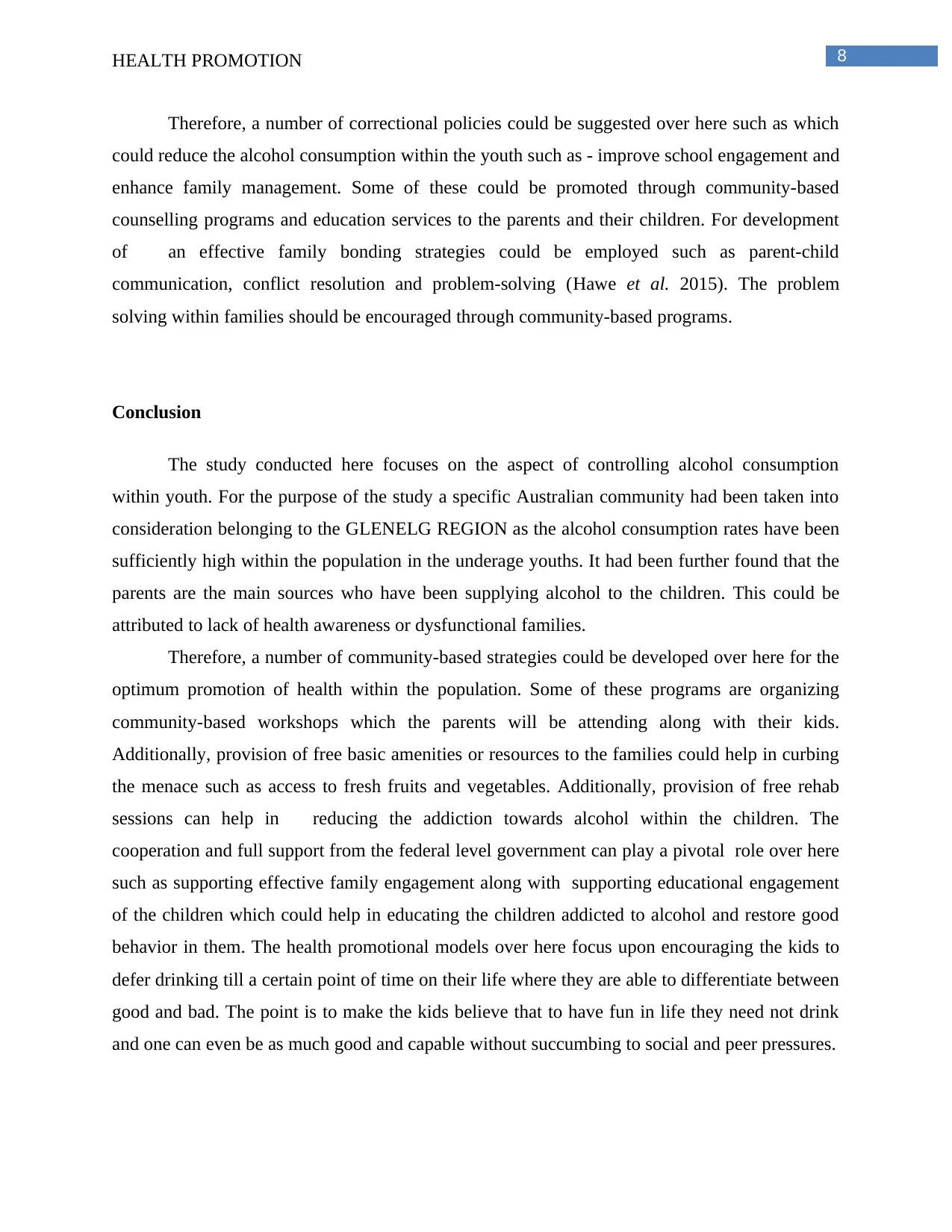
8HEALTH PROMOTION
Therefore, a number of correctional policies could be suggested over here such as which
could reduce the alcohol consumption within the youth such as - improve school engagement and
enhance family management. Some of these could be promoted through community-based
counselling programs and education services to the parents and their children. For development
of an effective family bonding strategies could be employed such as parent-child
communication, conflict resolution and problem-solving (Hawe et al. 2015). The problem
solving within families should be encouraged through community-based programs.
Conclusion
The study conducted here focuses on the aspect of controlling alcohol consumption
within youth. For the purpose of the study a specific Australian community had been taken into
consideration belonging to the GLENELG REGION as the alcohol consumption rates have been
sufficiently high within the population in the underage youths. It had been further found that the
parents are the main sources who have been supplying alcohol to the children. This could be
attributed to lack of health awareness or dysfunctional families.
Therefore, a number of community-based strategies could be developed over here for the
optimum promotion of health within the population. Some of these programs are organizing
community-based workshops which the parents will be attending along with their kids.
Additionally, provision of free basic amenities or resources to the families could help in curbing
the menace such as access to fresh fruits and vegetables. Additionally, provision of free rehab
sessions can help in reducing the addiction towards alcohol within the children. The
cooperation and full support from the federal level government can play a pivotal role over here
such as supporting effective family engagement along with supporting educational engagement
of the children which could help in educating the children addicted to alcohol and restore good
behavior in them. The health promotional models over here focus upon encouraging the kids to
defer drinking till a certain point of time on their life where they are able to differentiate between
good and bad. The point is to make the kids believe that to have fun in life they need not drink
and one can even be as much good and capable without succumbing to social and peer pressures.
Therefore, a number of correctional policies could be suggested over here such as which
could reduce the alcohol consumption within the youth such as - improve school engagement and
enhance family management. Some of these could be promoted through community-based
counselling programs and education services to the parents and their children. For development
of an effective family bonding strategies could be employed such as parent-child
communication, conflict resolution and problem-solving (Hawe et al. 2015). The problem
solving within families should be encouraged through community-based programs.
Conclusion
The study conducted here focuses on the aspect of controlling alcohol consumption
within youth. For the purpose of the study a specific Australian community had been taken into
consideration belonging to the GLENELG REGION as the alcohol consumption rates have been
sufficiently high within the population in the underage youths. It had been further found that the
parents are the main sources who have been supplying alcohol to the children. This could be
attributed to lack of health awareness or dysfunctional families.
Therefore, a number of community-based strategies could be developed over here for the
optimum promotion of health within the population. Some of these programs are organizing
community-based workshops which the parents will be attending along with their kids.
Additionally, provision of free basic amenities or resources to the families could help in curbing
the menace such as access to fresh fruits and vegetables. Additionally, provision of free rehab
sessions can help in reducing the addiction towards alcohol within the children. The
cooperation and full support from the federal level government can play a pivotal role over here
such as supporting effective family engagement along with supporting educational engagement
of the children which could help in educating the children addicted to alcohol and restore good
behavior in them. The health promotional models over here focus upon encouraging the kids to
defer drinking till a certain point of time on their life where they are able to differentiate between
good and bad. The point is to make the kids believe that to have fun in life they need not drink
and one can even be as much good and capable without succumbing to social and peer pressures.
⊘ This is a preview!⊘
Do you want full access?
Subscribe today to unlock all pages.

Trusted by 1+ million students worldwide
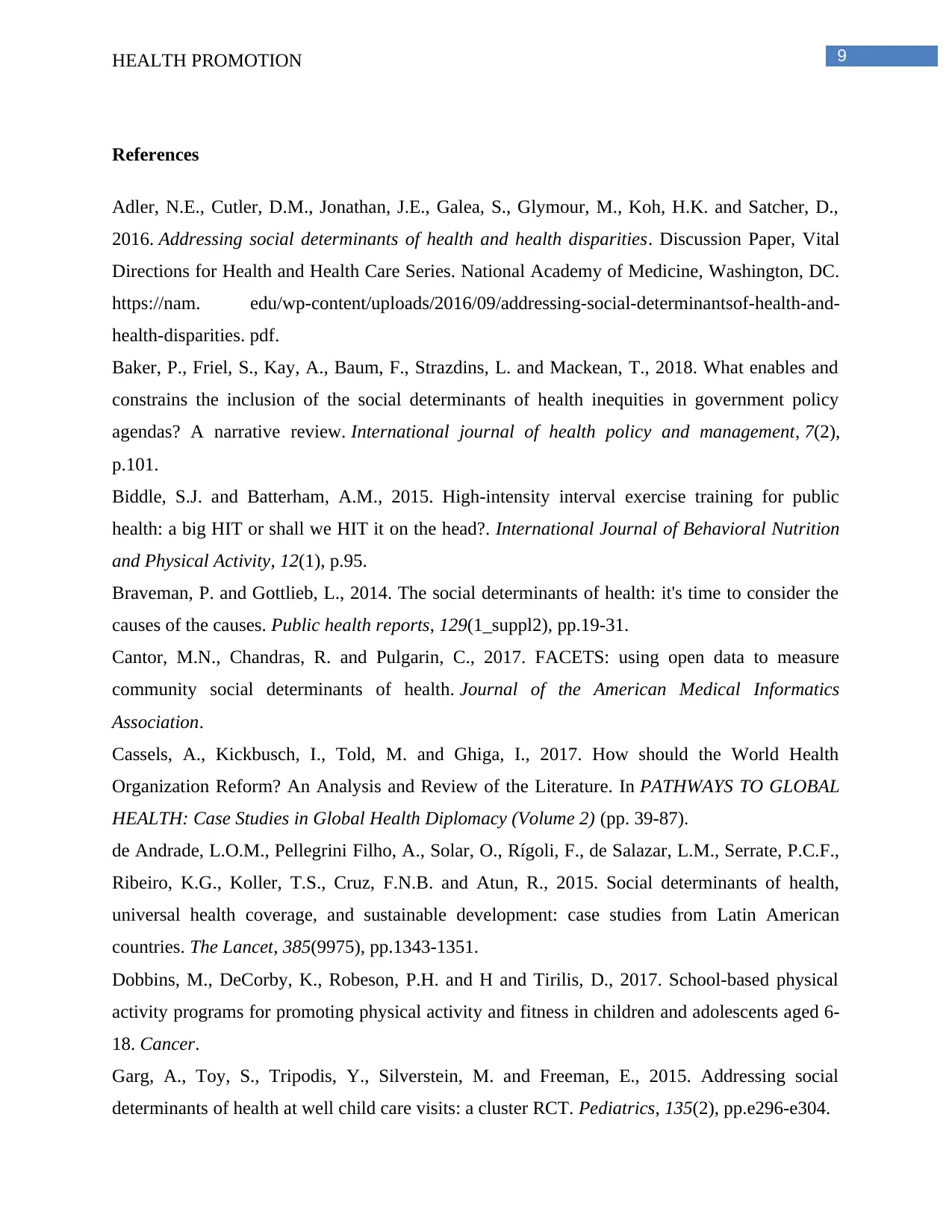
9HEALTH PROMOTION
References
Adler, N.E., Cutler, D.M., Jonathan, J.E., Galea, S., Glymour, M., Koh, H.K. and Satcher, D.,
2016. Addressing social determinants of health and health disparities. Discussion Paper, Vital
Directions for Health and Health Care Series. National Academy of Medicine, Washington, DC.
https://nam. edu/wp-content/uploads/2016/09/addressing-social-determinantsof-health-and-
health-disparities. pdf.
Baker, P., Friel, S., Kay, A., Baum, F., Strazdins, L. and Mackean, T., 2018. What enables and
constrains the inclusion of the social determinants of health inequities in government policy
agendas? A narrative review. International journal of health policy and management, 7(2),
p.101.
Biddle, S.J. and Batterham, A.M., 2015. High-intensity interval exercise training for public
health: a big HIT or shall we HIT it on the head?. International Journal of Behavioral Nutrition
and Physical Activity, 12(1), p.95.
Braveman, P. and Gottlieb, L., 2014. The social determinants of health: it's time to consider the
causes of the causes. Public health reports, 129(1_suppl2), pp.19-31.
Cantor, M.N., Chandras, R. and Pulgarin, C., 2017. FACETS: using open data to measure
community social determinants of health. Journal of the American Medical Informatics
Association.
Cassels, A., Kickbusch, I., Told, M. and Ghiga, I., 2017. How should the World Health
Organization Reform? An Analysis and Review of the Literature. In PATHWAYS TO GLOBAL
HEALTH: Case Studies in Global Health Diplomacy (Volume 2) (pp. 39-87).
de Andrade, L.O.M., Pellegrini Filho, A., Solar, O., Rígoli, F., de Salazar, L.M., Serrate, P.C.F.,
Ribeiro, K.G., Koller, T.S., Cruz, F.N.B. and Atun, R., 2015. Social determinants of health,
universal health coverage, and sustainable development: case studies from Latin American
countries. The Lancet, 385(9975), pp.1343-1351.
Dobbins, M., DeCorby, K., Robeson, P.H. and H and Tirilis, D., 2017. School-based physical
activity programs for promoting physical activity and fitness in children and adolescents aged 6-
18. Cancer.
Garg, A., Toy, S., Tripodis, Y., Silverstein, M. and Freeman, E., 2015. Addressing social
determinants of health at well child care visits: a cluster RCT. Pediatrics, 135(2), pp.e296-e304.
References
Adler, N.E., Cutler, D.M., Jonathan, J.E., Galea, S., Glymour, M., Koh, H.K. and Satcher, D.,
2016. Addressing social determinants of health and health disparities. Discussion Paper, Vital
Directions for Health and Health Care Series. National Academy of Medicine, Washington, DC.
https://nam. edu/wp-content/uploads/2016/09/addressing-social-determinantsof-health-and-
health-disparities. pdf.
Baker, P., Friel, S., Kay, A., Baum, F., Strazdins, L. and Mackean, T., 2018. What enables and
constrains the inclusion of the social determinants of health inequities in government policy
agendas? A narrative review. International journal of health policy and management, 7(2),
p.101.
Biddle, S.J. and Batterham, A.M., 2015. High-intensity interval exercise training for public
health: a big HIT or shall we HIT it on the head?. International Journal of Behavioral Nutrition
and Physical Activity, 12(1), p.95.
Braveman, P. and Gottlieb, L., 2014. The social determinants of health: it's time to consider the
causes of the causes. Public health reports, 129(1_suppl2), pp.19-31.
Cantor, M.N., Chandras, R. and Pulgarin, C., 2017. FACETS: using open data to measure
community social determinants of health. Journal of the American Medical Informatics
Association.
Cassels, A., Kickbusch, I., Told, M. and Ghiga, I., 2017. How should the World Health
Organization Reform? An Analysis and Review of the Literature. In PATHWAYS TO GLOBAL
HEALTH: Case Studies in Global Health Diplomacy (Volume 2) (pp. 39-87).
de Andrade, L.O.M., Pellegrini Filho, A., Solar, O., Rígoli, F., de Salazar, L.M., Serrate, P.C.F.,
Ribeiro, K.G., Koller, T.S., Cruz, F.N.B. and Atun, R., 2015. Social determinants of health,
universal health coverage, and sustainable development: case studies from Latin American
countries. The Lancet, 385(9975), pp.1343-1351.
Dobbins, M., DeCorby, K., Robeson, P.H. and H and Tirilis, D., 2017. School-based physical
activity programs for promoting physical activity and fitness in children and adolescents aged 6-
18. Cancer.
Garg, A., Toy, S., Tripodis, Y., Silverstein, M. and Freeman, E., 2015. Addressing social
determinants of health at well child care visits: a cluster RCT. Pediatrics, 135(2), pp.e296-e304.
Paraphrase This Document
Need a fresh take? Get an instant paraphrase of this document with our AI Paraphraser
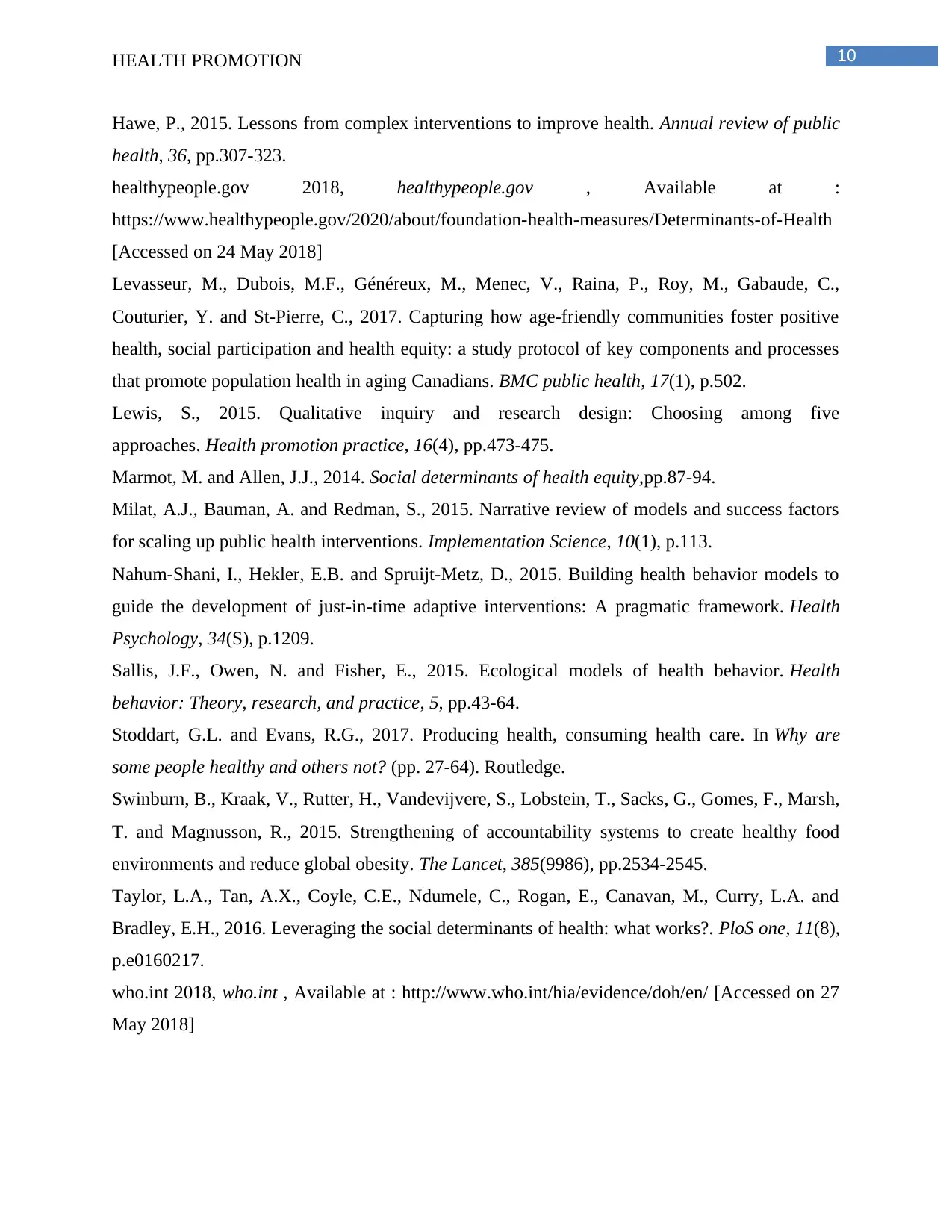
10HEALTH PROMOTION
Hawe, P., 2015. Lessons from complex interventions to improve health. Annual review of public
health, 36, pp.307-323.
healthypeople.gov 2018, healthypeople.gov , Available at :
https://www.healthypeople.gov/2020/about/foundation-health-measures/Determinants-of-Health
[Accessed on 24 May 2018]
Levasseur, M., Dubois, M.F., Généreux, M., Menec, V., Raina, P., Roy, M., Gabaude, C.,
Couturier, Y. and St-Pierre, C., 2017. Capturing how age-friendly communities foster positive
health, social participation and health equity: a study protocol of key components and processes
that promote population health in aging Canadians. BMC public health, 17(1), p.502.
Lewis, S., 2015. Qualitative inquiry and research design: Choosing among five
approaches. Health promotion practice, 16(4), pp.473-475.
Marmot, M. and Allen, J.J., 2014. Social determinants of health equity,pp.87-94.
Milat, A.J., Bauman, A. and Redman, S., 2015. Narrative review of models and success factors
for scaling up public health interventions. Implementation Science, 10(1), p.113.
Nahum-Shani, I., Hekler, E.B. and Spruijt-Metz, D., 2015. Building health behavior models to
guide the development of just-in-time adaptive interventions: A pragmatic framework. Health
Psychology, 34(S), p.1209.
Sallis, J.F., Owen, N. and Fisher, E., 2015. Ecological models of health behavior. Health
behavior: Theory, research, and practice, 5, pp.43-64.
Stoddart, G.L. and Evans, R.G., 2017. Producing health, consuming health care. In Why are
some people healthy and others not? (pp. 27-64). Routledge.
Swinburn, B., Kraak, V., Rutter, H., Vandevijvere, S., Lobstein, T., Sacks, G., Gomes, F., Marsh,
T. and Magnusson, R., 2015. Strengthening of accountability systems to create healthy food
environments and reduce global obesity. The Lancet, 385(9986), pp.2534-2545.
Taylor, L.A., Tan, A.X., Coyle, C.E., Ndumele, C., Rogan, E., Canavan, M., Curry, L.A. and
Bradley, E.H., 2016. Leveraging the social determinants of health: what works?. PloS one, 11(8),
p.e0160217.
who.int 2018, who.int , Available at : http://www.who.int/hia/evidence/doh/en/ [Accessed on 27
May 2018]
Hawe, P., 2015. Lessons from complex interventions to improve health. Annual review of public
health, 36, pp.307-323.
healthypeople.gov 2018, healthypeople.gov , Available at :
https://www.healthypeople.gov/2020/about/foundation-health-measures/Determinants-of-Health
[Accessed on 24 May 2018]
Levasseur, M., Dubois, M.F., Généreux, M., Menec, V., Raina, P., Roy, M., Gabaude, C.,
Couturier, Y. and St-Pierre, C., 2017. Capturing how age-friendly communities foster positive
health, social participation and health equity: a study protocol of key components and processes
that promote population health in aging Canadians. BMC public health, 17(1), p.502.
Lewis, S., 2015. Qualitative inquiry and research design: Choosing among five
approaches. Health promotion practice, 16(4), pp.473-475.
Marmot, M. and Allen, J.J., 2014. Social determinants of health equity,pp.87-94.
Milat, A.J., Bauman, A. and Redman, S., 2015. Narrative review of models and success factors
for scaling up public health interventions. Implementation Science, 10(1), p.113.
Nahum-Shani, I., Hekler, E.B. and Spruijt-Metz, D., 2015. Building health behavior models to
guide the development of just-in-time adaptive interventions: A pragmatic framework. Health
Psychology, 34(S), p.1209.
Sallis, J.F., Owen, N. and Fisher, E., 2015. Ecological models of health behavior. Health
behavior: Theory, research, and practice, 5, pp.43-64.
Stoddart, G.L. and Evans, R.G., 2017. Producing health, consuming health care. In Why are
some people healthy and others not? (pp. 27-64). Routledge.
Swinburn, B., Kraak, V., Rutter, H., Vandevijvere, S., Lobstein, T., Sacks, G., Gomes, F., Marsh,
T. and Magnusson, R., 2015. Strengthening of accountability systems to create healthy food
environments and reduce global obesity. The Lancet, 385(9986), pp.2534-2545.
Taylor, L.A., Tan, A.X., Coyle, C.E., Ndumele, C., Rogan, E., Canavan, M., Curry, L.A. and
Bradley, E.H., 2016. Leveraging the social determinants of health: what works?. PloS one, 11(8),
p.e0160217.
who.int 2018, who.int , Available at : http://www.who.int/hia/evidence/doh/en/ [Accessed on 27
May 2018]
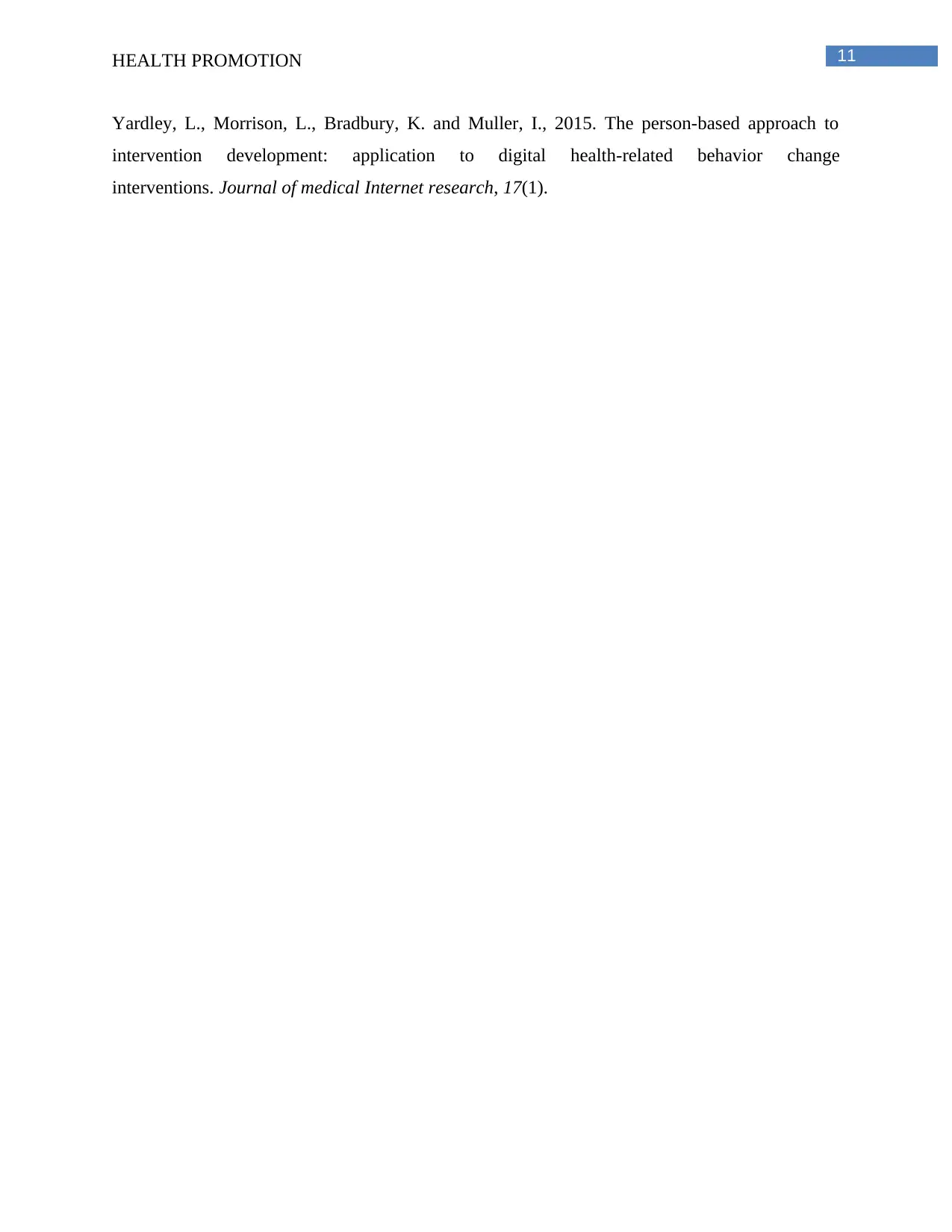
11HEALTH PROMOTION
Yardley, L., Morrison, L., Bradbury, K. and Muller, I., 2015. The person-based approach to
intervention development: application to digital health-related behavior change
interventions. Journal of medical Internet research, 17(1).
Yardley, L., Morrison, L., Bradbury, K. and Muller, I., 2015. The person-based approach to
intervention development: application to digital health-related behavior change
interventions. Journal of medical Internet research, 17(1).
⊘ This is a preview!⊘
Do you want full access?
Subscribe today to unlock all pages.

Trusted by 1+ million students worldwide
1 out of 12
Related Documents
Your All-in-One AI-Powered Toolkit for Academic Success.
+13062052269
info@desklib.com
Available 24*7 on WhatsApp / Email
![[object Object]](/_next/static/media/star-bottom.7253800d.svg)
Unlock your academic potential
Copyright © 2020–2025 A2Z Services. All Rights Reserved. Developed and managed by ZUCOL.




